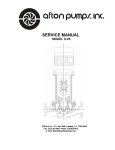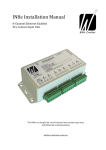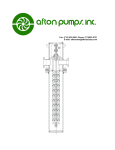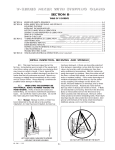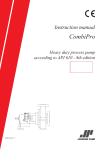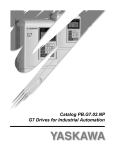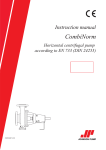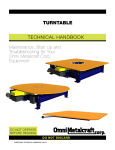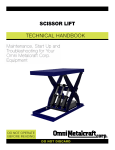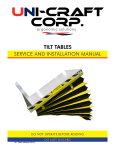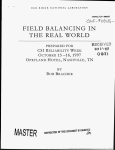Download SERVICE MANUAL
Transcript
7335 Ave. N, P.O. Box 9426, Houston, Tx. 77261-9426 Fax: (713) 923-3902 Phone: (713)923-9731 E-mail: [email protected] MODEL GSV SERVICE MANUAL SERVICE MANUAL GENERAL INTRODUCTION: Afton pumps have been designed and tested to give dependable, trouble-free service with a minimum amount of attention. To insure dependable operation the pump unit must be properly installed, operated and serviced. Because of the variety of installations in which these pumps are used, this manual can only provide general information. For specific information not contained in this manual contact an Afton dealer. WARRANTY: will be made for repairs or alterations unless made with its written consent or approval. Afton Pumps shall not be held responsible for work done, apparatus furnished, or repairs made by others. Warranty on equipment and accessories produced by other manufacturers is limited to warranty of the respective manufacturer. Afton Pumps, Inc. warrants the equipment of its manufacture against defects in material and workmanship under normal use for a period of one year after date of shipment. The Company’s obligation under this warranty is limited, however, to furnishing or repairing, without charge, F.O.B. its factory, a similar part to replace any part of its equipment which within one year from date of shipment is found to have been defective at the time it was shipped. The Purchaser must give Afton Pumps immediate written notice upon finding such defect. Afton Pumps shall have the option of requiring the return of the defective material transportation prepaid, to establish the claim. Afton Pumps shall in no event be held liable for damages or delay caused by defective material and no allowance There are no warranties, expressed or implied, except as stated in this warranty. Afton Pumps shall not be liable for any special, indirect, or consequential damages resulting in any manner from the furnishing of this equipment or for any damages of any kind arising from the use of this equipment. -CAUTIONMotor for this unit is designed to operated in a vertical position. DO NOT attempt to transport, install, or otherwise handle horizontally. Small motors, with grease lubricated bearings top and bottom, that were mounted on the pump at the factory are an exception to this rule. DO NOT attempt to install or operate without reading this manual. DO NOT store this unit in an unprotected area. The unit was reasonably protected from field damage and rust prior to shipment, but extended unprotected storage will cause problems specifically in the coupling and mechanical seal areas. DO CHECK for shipment damage and missing parts immediately upon receipt of equipment. All shipments are F. O. B. shipping point. 1 TABLE OF CONTENTS SUBJECT PAGE COVER GENERAL WARRANTY INFORMATION 1 TABLE OF CONTENTS 2 GENERAL DESCRIPTION Utility Service Hydrocarbon Process Service Chemical Handling 3 AFTON 4 PIECE ADJUSTABLE SPACER COUPLING 4 DRIVER MOUNTING AND ALIGNMENT COUPLING INSTALLATION AND ADJUSTMENT 5 TYPICAL GSV CROSS-SECTION 6 GSV CROSS-SECTION 7 START-UP AND OPERATION Check List Start-Up Lubrication Operational Problems 8 WEAR RING AND SLEEVE BEARING CLEARANCES 9 TECHNICAL DATA SECTION Bushing and Bearing Selection for Vertical Pumps 10 TROUBLE CHECK LIST 11 MODEL GSV GENERAL INSTALLATION The Afton Model GSV general service vertical pump was designed by engineers experienced in vertical pump design, operation, and repair to provide a rugged, simple machine capable of moving a wide variety of liquids from open pits or closed sub surface vessels. The following service classifications have construction features described available: UTILITY SERVICE For reasonable clean non-toxic, non-volatile liquids with slight corrosive characteristics and some lubricating qualities. Pumps of this design for flow rates to 5000 gal/min. will be offered with cast iron discharge heads, vertical hollow shaft drivers, packed stuffingboxes, steel column pipe, iron bowls, 416 shafts, bronze closed impellers and bronze bearings. Flow rates above 5000 GPM are normally fitted with fabricated steel discharge heads. Lubrication by pumpage. HYDROCARBON PROCESS SERVICE For reasonably clean liquids will be offered with fabricated steel discharge heads, iron bowls, bronze enclosed impellers, bronze bearings, 416 shafts, and steel column pipe. Lubrication by pumpage. Drivers are vertical hollow shaft with packed stuffingboxes or vertical solid shaft with spacer coupling when an optional mechanical seal is required. CHEMICAL HANDLING Liquids with little or no lubricating qualities and moderate to high corrosive characteristics are handled by a basic design having open impellers, carbon bearings, and properly selected corrosion resistant metallurgy. Discharge heads for packed stuffing boxes are normally cast (to 5000 GPM) and fabricated when used with mechanical seals and flow rates above 5000 GPM. All units with mechanical seals are furnished with spacer couplings. Special modification for any of the above service groups may be required due to: A. Liquids containing appreciable amounts of solids such as mill scale, sand, coke, or any other unusually dirty services should be handled with oil lubricated column and open iron impellers. A fresh water or grease injection to the bowl bearings is available, if desired, and speeds are reduced to extend life expectancy. B. Vapor proof construction for volatile or toxic liquids utilizes single or double seals and gasketed head mounting surface. This construction requires a fabricated discharge head and will prevent dangerous or unpleasant vapors from escaping the sump and allow a vertical pump to deliver direct from a pressurized tank, if desired. Afton experience has indicated the following design features are desirable and are, therefore, our standard: Adjustable flanged couplings - when solid shaft drivers require the use of a coupling the obviously superior flanged design is always used. One piece shaft design with no line shaft couplings subject to corrosion, reverse rotation, and improper assembly is standard for shaft lengths to 15', and is available for shafts to 20'. Integral bearing cages manufactured with column and bearing cages welded and machined as one piece positively prevents mis-assembly of these components. Adequate down thrust to keep the shaft in tension and prevent vibration and shaft deflection in built into our impeller design. Flanged bowl assembly and column is standard on 10" and larger bowls and available but not normally recommended on 6" and 8". In addition to the above noted specific design features our flexibility of construction allowing cast or fabricated discharge heads, open or closed impellers, pumpage or oil lubrication, flanged or bolted bowl assemblies, and single or multi-stage construction with turbine, mixed flow, or propeller bowl assemblies allow Afton to quickly ship the correct unit for your application for 5 to 50,000 GPM at 2' to 2000' TDH. 3 ITEM# DESCRIPTION 002 MOTOR HUB COUPLING 003 PUMP SHAFT ADJUSTING NUT 004 SPACER COUPLING 005 PUMP SHAFT COUPLING HUB 203 PUMP SHAFT 283 COUPLING CAPSCREWS & NUTS 285 STRAIGHT KEY, PUMP & MOTOR 288 MOTOR CIRCULAR KEY 391 MOTOR Afton Pumps 4- piece Adjustable Spacer Coupling 4 DRIVER MOUNTING AND ALIGNMENT COUPLING INSTALLATION AND ADJUSTMENT APPLYING TO ALL MODEL HPV, MPV AND GSV UNITS HAVING SOLID SHAFT MOTORS Pumps of this type are supplied with a split ring designed to transmit both up and down thrust from the pump to the driver. This ring eliminates the need for pinning and/or set screwing the driver-coupling hub to the driver shaft. Units up to and including 20 HP will normally be shipped with the motor mounted and no coupling adjustment required. All larger units will normally have the pump and motor shipped separately. In this case, the coupling drawing should be reviewed prior to assembly. When pump and motor are shipped assembled, check the runout of the pump shaft between the coupling hub and the drive collar. If it is within .002" T.I.R., proceed with installation and startup; if it exceeds .002" T.I.R., motor has shifted during shipment or assembly has been damaged in some way. In this case, unbolt coupling and check alignment as described in Method “B” below. When pump and motor are shipped separately, set the motor on the pump. Normally the conduit box location can be o rotated in 90 increments, so position the conduit box as desired. Refer to the coupling drawing mentioned above. At this point, it is left to the discretion of the millwright, the manner in which assembly should proceed. Obviously a 500 HP unit operating at 3600 RPM would require a more precise alignment for optimum longevity than a a 10 HP unit operating at 1200 RPM. Therefore, the millwright should decide the desired degree of accuracy and proceed according to method “A” or “B” outlined below. A) Alignment: Secure the motor to the head with the motor hold-down bolts and tighten same. Assemble the coupling with the adjusting nut in the proper relative position. Model HPV pumps should operate with a rotating element midway in the end play. Model MPV pumps with enclosed impellers sizes 2"x3"x6" through 18"x20"x24" should operate approximately .050 to .100 from the bottom of the end play. Model MPV pumps above 18"x20"x24" should operate approximately 3/4" from the bottom of the endplay. All Model MPV pumps with open impellers should operate .020" to .030" above the bottom of endplay. Model GSV (same as MPV). Care should be exercised at this time to be absolutely certain that the unit is not dragging after coupling is completely assembled and tightened. With the element correctly positioned and the coupling correctly assembled and tightened, tighten all drive collar set screws. During assembly of the coupling, be sure all bolts and nuts are of the same size so no unbalance will be present. The drive collar at this time should run 1/8" above the gland. Place an indicator stand on the pump head with the indicator button resting on the o pump shaft between the coupling hub and the drive collar. Rotate the shaft 360 several times. If the T.I.R. does not exceed .002", the unit is suitable for operation. If the shaft runout exceeds .002", you should disassemble the coupling and proceed as outlined in method “B” described below. B) For an exact alignment or to locate the cause of a misalignment proceed as follows: 1) Check the runout of the motor shaft. It should not exceed .001". 2) Locate the motor in reference to the discharge head; this may be done by clamping an indicator on the motor shaft with a button resting on an ID fit in the top of the discharge head. On the smaller size units where there is no cleanup cut, secure indicator to o motor hub and with the indicator button resting on pump shaft rotate motor shaft 360 . The runout may be appreciable but shifting o the motor in the correct direction will tend to eliminate this misalignment. When T.I.R. is within .005", rotate pump shaft 90 at a o o time, three (3) times, stopping at each 90 point and checking alignment by rotating motor shaft 360 . Do not shift the motor during these three (3) movements. However, it may be wise to make a simple sketch showing plus and minus points for each quadrant. After you have done this you will note pump shaft is probably not in exact center of stuffingbox. However, by reviewing your readings you will be able to determine how much and in what direction motor should be shifted to assure T.I.R. between o pump and motor shafts when both are rotated through 360 will not exceed .005. In other words, with the indicator clamped to the motor shaft (or motor coupling hub) an indicator button resting on and reading from pump shaft, you should be able to rotate o o motor shaft 360 four (4) times (when pump shaft is rotated at 90 intervals) with T.I.R. never exceeding .005". When this is accomplished motor hold-down bolts should be tightened. 3) At this point read and follow instructions in paragraph “A” above. As you assemble coupling, check runout of coupling hub O.D. and faces to be sure no fits have been damaged in handling (O.D. runout should not exceed .002" and mating face runout should not exceed .001"). NOTES: Motor rotation should be checked before pump and motor is connected. Pump must not be under pressure during impeller adjustment. Maximum and operating thrust on pumps of this type are normally down however, some momentary up thrust can be expected. 5 TYPICAL GSV CROSS-SECTION 6 TYPICAL GSV CROSS-SECTION 7 MODEL GSV START-UP AND OPERATION Check List: a. Is motor properly lubricated? b. Is coupling on units with solid shaft motors properly installed, adjusted, and tightened? Is head shaft nut on units with hollow shaft motors properly adjusted? c. Is motor securely bolted down? d. Has motor rotation been checked? CAUTION...Do not check rotation with unit coupled up and do not attempt to operate without checking rotation. e. Is all piping connected and tightened? f. Does pump turn freely? g. Pumps fitted for oil lubrication must have the oil pot installed and filled. You should allow the oil approximately 30 minutes of about 10 drops per minute operation before starting pump. h. Are shut-down devices installed? ix. Is discharge pressure gauge installed? j. Are mechanical seal drive collar set screws (if so equipped) tight? Is packing (if so equipped) installed, lubricated, and lightly tightened? k. Is adequate liquid actually visible in the pit? Start-Up: Crack open the discharge valve, push the starter button, and slowly open the discharge valve while observing the discharge gauge. If a sudden drop in discharge pressure is observed, shut the unit down, rapidly close the discharge valve and determine the cause. When design discharge pressure is reached, immediately check current with an ammeter and compare to nameplate amps. Allow the unit to operate until temperature and flow rates have stabilized. (Minimum one (1) hour on larger units) before leaving unattended. Lubrication: None normally required by pump. Refer to motor manual for motor lubrication information. Oil lube pumps see above. Operational Problems: If you feel that not all is in order, refer to trouble checklist on back page. 8 ENGINEERING DATA SECTION Wear Ring Clearances: The following data is in accordance with API 610 specifications and shall be considered an Afton standard where applicable. For cast iron, bronze, hardened 11 to 13 per cent chromium, and materials of similar galling tendencies, the following running clearances shall be used: Diameter of Rotating Member at Clearance (Inches) Less than 2" 2.000" to 2.499" 2.500" to 2.999" 3.000" to 3.499" 3.500" to 3.999" 4.000" to 4.499" 4.500" to 4.999" 5.000" to 5.999" 6.000" to 6.999" 7.000" to 7.999" 8.000" to 8.999" 9.000" to 9.999" 10.000" to 10.999" 11.000" to 11.999" Minimum Diametrical Clearance (Inches) 0.010" 0.011" 0.012" 0.014" 0.016" 0.016" 0.016" 0.017" 0.018" 0.019" 0.020" 0.021" 0.022" 0.023" Generally speaking, a wear ring clearance should be renewed whenever the initial clearance is doubled. Materials with severe galling tendencies such as 18-8 stainless steel will require increased clearances. Sleeve Bearing Clearances: Afton vertical pumps using pumpage lubricated sleeve bearings and throat bushings of bronze or carbon running against steel, 416, or 18-8 shafts (or shaft sleeves) shall have the following running clearances: Diameter of rotating member Clearances .075 to 1.500 .004" to .006" 1.500 to 2.500 .006" to .008" Pumps repaired under Afton’s supervision are to have clearances renewed to above specifications when initial clearance is doubled. 9 TECHNICAL DATA SECTION Bushing and Bearing Selection for Vertical Pumps The following materials are available for consideration as interstage and lineshaft bearings on Afton Model GSV, MPV, and HPV pumps and stuffingbox bushings on Model ILVS In-Line pumps: Bronze Use whenever possible. Do not use on any corrosive service unless pump is all o o bronze. Do not use above 200 F or below –20 F without Engineering Department approval. Do not use on sandy well water. Do not use on dirty water sump service. Carbon Second choice after bronze. Use when corrosive products prelude the use of bronze and product lubricity is low; for example, propane containing o hydrogen sulfide. Do not use unless pumpage is clean. Use below –20 F. Remember the coefficient of thermal expansion is practically zero. Iron Use on mildly corrosive service: for example, sour crude. Use for o temperatures above 200 F. Use where particles in the product prelude the use of carbon. Use only on products with fair or better lubricity. Rubber Applicable only to Model GSV pumps and water wells. Use in conjunction with open impeller on sandy well water or dirty sump service. Do not use in hot service or where any product detrimental to neoprene is present. Teflon, glass filled or otherwise Use only at customer’s insistence and with management approval. Suggest carbon for most services where Teflon is specified. For simplicity we are referring to the materials by their most common name. We are not using trade names or compositions, but please note each material has components added to improve its suitability as a bearing material. 10 TROUBLE CHECK LIST (Applies to All Afton Model GSV Pumps) Should you feel the pump is not doing the job for which it was sold a few simple checks and observations will help locate the trouble. To make these checks you will need a pressure gauge, located at the pump discharge, an ammeter, and a performance curve applying to the pump. 1) IMPELLER ADJUSTMENT The impeller should run close to the bottom of the bowl assembly, approximately .020" to .040" clearance for open impellers and .040" to .080" for closed. Complete instructions for setting this clearance are in the installation section of this booklet. Units above 18x24 should operate approximately ½" up from bottom of endplay 2) ALIGNMENT Does unit rotate freely? Is alignment within specified tolerances? 3) ROTATION Unit rotation must be Counter Clockwise (CCW) looking down on motor. 4) NOISE & VIBRATION Does pump have either at operating point and/or shut-off? (If so, do not operate until these conditions are corrected). 5) VORTEXING Are whirlpools observed near pump suction? Check required submergence. 6) NPSH Is pumpage temperature above ambient? Is pump suction clogged? 7) DISCHARGE PRESSURE & AMPERAGE Check both with discharge valve closed, one-half open, and fully open. 8) VOLTAGE Is it within approximately 10% of design? Is motor, wired correctly? 9) CORRELATE READINGS A) Discharge PSIG x 2.31 Pumpage specific gravity + Distance Down To Liquid Level B) Operating H.P. Motor Nameplate H.P. approximately equals C) T.D.H. x Gal. Per Min. (2) 3960 x Pump Eff. (1) x Specific Gravity = H.P. = Total Differential Head (TDH) Amp Readings Full Load Amps 1) From pump Performance Curve 2) Read from pump curve and estimate with various valve openings If after checking the above, you still feel the pump is not performing as it should, prepare to remove and dismantle. Should pump still be in warranty. AFTON would appreciate the opportunity of discussing the unit with you prior to its removal. 11












